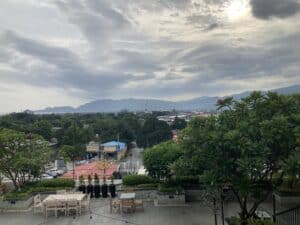Catchment Management
Through the consideration of community, science, and policy, we develop meaningful and resilient solutions that have catchment-scale impact.
Adopting a catchment-level approach
Adopting a catchment-level approach to environmental monitoring and resource allocation offers multiple benefits for those living and relying on catchment environment services. Informed decision-making through the provision of quality meaningful information leads to risk mitigation, enhanced resource efficiency, biodiversity conservation, and increased resilience to environmental challenges, which benefits all.
By embracing integrated and collaborative management practices, and establishing meaningful monitoring systems, catchment stakeholders have the tools to capitalise on collaboration and funding opportunities to achieve sustainable land use and secure livelihoods for future generations.
Why work with us
Our team are experts in identifying cost-effective and impactful information and nature-based solutions that protect, sustainably manage, and restore natural and modified ecosystems.
Our approach considers the interconnectedness of land, water, and ecosystems, aiming to identify optimal resource use while minimising negative impacts and risks.
Here’s how EAS can work with your Catchment Management Group:
We collaborate with your Catchment Management Group to establish advanced monitoring systems, bridging the gap between stakeholders and the health of your catchment area. These systems enable data-driven decision-making, provide early warning for adverse events, facilitate predictive analytics,, support policy development and evaluation, and showcase the value of action.
We aid in unlocking market-based opportunities for nature repair and restoration, including projects in regulatory and voluntary carbon and biodiversity markets. This is achieved through comprehensive market analysis, rigorous project due diligence, and meticulous development processes that cover measurement, reporting, and verification requirements. With our expertise in developing high-standard systems, clients can focus on advancing conservation and effective land management, assured of their project’s quality and compliance.
We amplify your group’s catchment management capabilities through improved communication, stakeholder engagement, and community participation. Tailored communication materials and multi-channel outreach ensure widespread message dissemination. Workshops and participatory decision-making processes encourage collaboration and hands-on learning. By backing community-led monitoring and advocacy, we focus on elevating catchment management efforts, effectively integrating risk mitigation with the pursuit of environmental opportunities.
EAS is committed to collaborating closely with your Catchment Management Group to effectively mitigate risks and uncover valuable opportunities. By leveraging our expertise in environmental assessment and strategic planning, we can work together to address the unique challenges faced by your catchment, ensuring a balanced approach to water management, land use, and biodiversity conservation.
Nature Repair Course
Australia’s Nature Repair Act 2023 (the Act) came into effect on 15 December 2023. The Act establishes a framework for a world-first legislated, national, voluntary biodiversity market. The Clean Energy Regulator will administer both the Nature Repair Market and the Australian Carbon Credit Unit (ACCU) Scheme to support alignment between carbon and biodiversity markets.
We provide capacity-building sessions for catchment groups on how to support landowners to identify and maximise Nature Repair projects.
View our course outline and register your interest here.
Key projects
WAI Wanaka
Developed a comprehensive monitoring system of key environmental and social indicators to provide a continuous update of the Upper Clutha catchment health status. The monitoring system consisted of documented indicators, quantification methodologies, and identification of data sources, which resulted in an annual state of the catchment report which we made available in both hard copy and through an interactive website that EAS developed in-house.
South East Councils Climate Action Alliance (SECCCA)
Conducted an assessment of carbon and biodiversity opportunities across the nine councils in Victoria’s south-east which are part of SECCCA. The investigation conclusively identified areas eligible under the ACCU scheme, alongside pinpointing opportunities for the creation and enhancement of biolinks. This approach aims at driving both environmental and social enhancements within the region, while also unveiling avenues for potential financial returns. Our project collaborators, HWL Ebsworth Lawyers, provided counsel on establishing an EcoFund to aid in long-term restoration efforts. Additionally, we offered guidance on the Nature Repair Market, which was in the development stage during the project’s timeline.
Hakataramea Catchment Group
Catchment Management Resources
About Environmental Accounting Services
As a purpose-led professional services consulting company with over two decades of experience, we are dedicated to delivering impactful, science-based solutions that create a positive impact.
Our team specialises in land sector environmental reporting, climate disclosures, methodology development, capacity building, and implementation – aligned with international best practice.
We love sharing our knowledge to build your capacity so you can pass it on.
Our Projects

Pioneering Sustainable Fisheries: Moana New Zealand’s Journey to Achieving Science-Based Targets
Moana New Zealand, the largest Māori–owned fisheries company in Aotearoa (New Zealand), has long been a steward of some of the world’s most pristine and

How Active Massage Cut Their Carbon Footprint by 59%
Witnessing the impacts of climate change firsthand in her native home of Florida, Gray Campbell understands the severe effects it can have on a beautiful

Enhancing Carbon and Energy Management Training: A Success Story with Carbon Energy Professionals
As the need for expertise in climate change and energy management grows, Carbon Energy Professionals (CEP), a leader in carbon and energy management training, recognised

Enhancing emissions transparency: Ruminati’s commitment to SBTi standards
This case study explores how EAS collaborated with Ruminati to align its emissions tracking tool with the standards and guidelines of the SBTi.

Pioneering sustainable event management with QLDC, Wastebusters, and WAO
Queenstown Lakes District Council (QLDC) and Wastebusters, in partnership with WAO, are proactively working to improve the understanding of the environmental impact of events.

How EAS designed a blueprint for land sector MRV in Timor-Leste
This case study details an ambitious endeavour to leverage carbon farming and design MRV for the land sector in Timor Leste.

